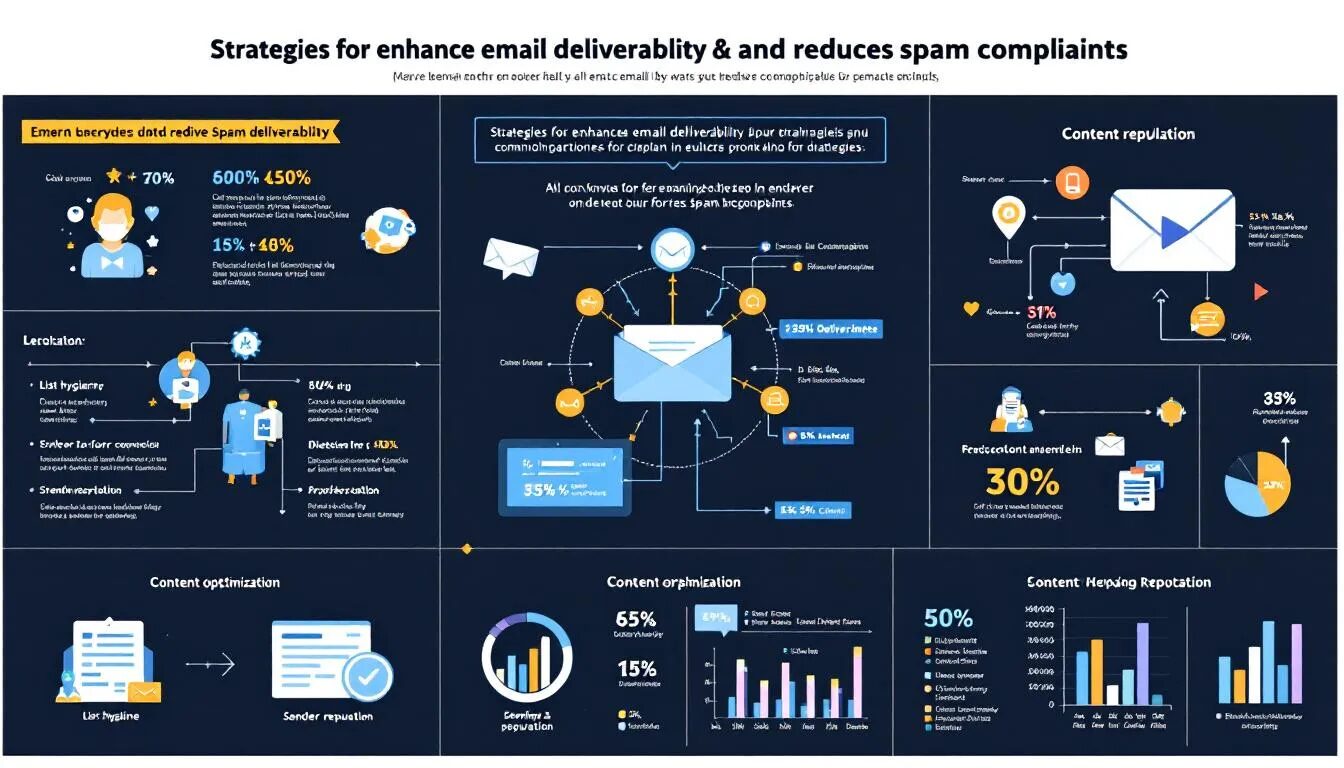
Top Automation Tools to Connect with VerticalResponse
Marketing teams spend countless hours on repetitive tasks that could be automated, from manually importing contacts to scheduling messages across multiple marketing channels. The right automation tools can transform your VerticalResponse email marketing from a manual process into a streamlined, efficient machine that generates leads while you focus on strategy.
With so much competition among automation tools in the market, businesses must carefully evaluate the strengths and weaknesses of each platform to choose the best fit for their needs.
VerticalResponse integrates with over 15 automation platforms, enabling businesses to connect their email marketing with CRMs, forms, e-commerce sites, and other essential marketing software. Many users are drawn to the appeal of using one app to manage multiple marketing workflows, as some platforms offer all-in-one solutions for integration and automation. Whether you’re a small business owner managing your customer journey manually or part of a larger marketing team looking to scale automated workflows, these integration tools can save time and dramatically improve your marketing automation capabilities.
Introduction to Marketing Automation
Marketing automation is the use of technology to streamline and automate marketing processes, allowing businesses to operate more efficiently and effectively. By implementing marketing automation software, companies can automate repetitive tasks such as sending emails, managing contact lists, and tracking customer interactions across various marketing channels. This not only saves time but also ensures that marketing efforts are consistent and targeted throughout the customer journey. Automation tools integrate seamlessly with email marketing, social media, and other digital platforms, enabling businesses to generate and nurture leads with minimal manual intervention. As a result, marketing teams can focus on strategy and creative initiatives, while automation handles the day-to-day tasks that drive sales and business growth.
Key Takeaways
- VerticalResponse integrates with 15+ automation platforms including Zapier, Make, and specialized email marketing tools
- Zapier offers the most extensive VerticalResponse integrations with 500+ trigger and action combinations
- Popular automations include adding contacts from form submissions, syncing CRM data, and triggering email campaigns
- Integration costs range from free plans to $299/month for enterprise automation platforms
- Most tools offer drag-and-drop workflow builders requiring no coding experience
- Compare the features, pricing, and integration capabilities of different automation platforms to ensure you choose the best fit for your needs
Benefits of Automation
The advantages of marketing automation extend far beyond just saving time. By automating repetitive tasks like scheduling messages and managing campaigns, businesses can significantly increase their operational efficiency. Automation tools empower marketers to focus on high-impact activities, such as developing creative strategies and analyzing campaign performance, rather than getting bogged down in manual processes. Additionally, marketing automation enables personalized communication with customers, delivering tailored messages based on individual behaviors and preferences. This leads to higher engagement rates and more effective lead generation. With built-in analytics and tracking, automation tools provide valuable insights into customer interactions, allowing marketers to measure results, optimize campaigns, and make data-driven decisions that enhance overall marketing performance.
Marketing Automation Strategies
Successful marketing automation strategies are built on a deep understanding of the customer journey and the ability to deliver personalized, timely messages across multiple marketing channels. By leveraging marketing automation software, businesses can design automated workflows that nurture leads from initial contact to conversion. For example, a company might set up an automated email series for new subscribers, followed by targeted offers based on their engagement. Automation tools can also trigger social media ads or SMS messages in response to specific customer actions, ensuring a cohesive experience across all touchpoints. Integrating marketing automation with other tools, such as CRM software and Google Sheets, allows businesses to centralize customer data and create highly relevant, personalized campaigns. This unified approach not only streamlines marketing efforts but also drives sales and maximizes the impact of every customer interaction.
Best Automation Platforms for VerticalResponse Integration
The automation tools market has evolved significantly, with platforms now offering user friendly interfaces that make connecting VerticalResponse to other apps accessible to marketers without technical backgrounds. Here are the top platforms that excel at VerticalResponse integration:
Most leading automation platforms also provide extensive resources such as tutorials, support teams, and integration guides to help users get started and troubleshoot issues.
Zapier – The Market Leader
Zapier stands out as a top marketing software platform, connecting over 1,000 apps to help businesses automate their marketing processes with ease. Its user friendly interface allows marketers to create automated workflows—known as Zaps—that link popular tools like HubSpot, Mailchimp, and Facebook with their email marketing and CRM systems. For example, a business can use Zapier to automatically update contact records in their CRM whenever a new subscriber joins their email list, instantly triggering targeted campaigns without manual input. With its extensive app library and intuitive workflow builder, Zapier makes it simple for businesses of all sizes to streamline their marketing efforts, improve efficiency, and ensure that every campaign reaches the right audience at the right time.
Make (Formerly Integromat) – Advanced Workflow Automation
Make (formerly Integromat) is a powerful automation tool designed for businesses seeking advanced workflow automation across multiple marketing channels. With features like conditional logic, data manipulation, and robust API integrations, Make is ideal for technical users and companies with complex data needs. Businesses can use Make to automate intricate processes, such as extracting data from emails, syncing information between platforms, or orchestrating multi-step marketing campaigns that span several tools. For example, a company might set up a workflow that collects leads from various sources, enriches the data, and then distributes personalized messages across different channels—all without manual intervention. By automating these repetitive tasks, Make enables businesses to boost productivity, maintain data accuracy, and scale their marketing automation efforts for greater revenue growth.
Zapier – The Market Leader
Zapier dominates the automation space with over 6,000 app connections and the most comprehensive VerticalResponse integration available. The platform offers more than 500 pre-built automation templates specifically for VerticalResponse, making it the go-to choice for businesses looking to automate their email marketing workflows.
Key Features:
- Over 500 VerticalResponse automation templates
- Connects with popular CRM systems like HubSpot, Salesforce, and Pipedrive
- Multi-step workflows with conditional logic
- Real-time data synchronization
- Free plan with 100 tasks per month
Pricing: Free plan available, paid plans start at $19.99/month
Zapier excels at automating email sequences triggered by customer actions. For example, when a new subscriber completes a form on your site, Zapier can automatically add them to a specific VerticalResponse list, tag them based on their interests, and trigger a welcome email campaign – all without manual intervention.
Make (Formerly Integromat) – Advanced Workflow Automation
Make appeals to marketers who need more sophisticated automation capabilities than basic trigger-action workflows. The platform’s visual workflow builder allows you to create complex automations with advanced data transformation and conditional routing.
Key Features:
- Visual drag-and-drop workflow builder
- Advanced data transformation capabilities
- Webhook support for real-time synchronization
- JSON parsing for custom API integrations
- Robust error handling and logging
Pricing: Free plan with 1,000 operations monthly, professional plans from $9/month
Make shines when businesses need to process data from multiple sources before adding contacts to VerticalResponse. The platform can parse customer data from various touchpoints, cleanse and format it, then automatically created new personalized contact profile records with custom fields and targeted list assignments.
Microsoft Power Automate – Enterprise Integration
Power Automate serves organizations already embedded in the Microsoft 365 ecosystem. While it doesn’t offer as many third-party app connections as Zapier, it provides enterprise-grade security and seamless integration with Office applications.
Key Features:
- Deep Microsoft 365 integration
- Advanced approval workflows
- On-premises system connectivity
- Enterprise security and compliance features
- Integration with Teams, Outlook, and SharePoint
Pricing: Included with Microsoft 365 subscriptions, standalone plans from $15/month
Power Automate works particularly well for companies that manage customer relationships through Microsoft tools. Sales teams can automatically sync lead data from Dynamics CRM to VerticalResponse, ensuring prospects receive timely follow-up emails based on their position in the sales funnel.
IFTTT – Simple Trigger-Based Automation
IFTTT (If This Then That) focuses on simple, trigger-based automations perfect for small businesses or individuals who need basic VerticalResponse connectivity without complex workflows.
Key Features:
- Simple trigger-action automations
- Pre-built “applets” for common scenarios
- Mobile app for managing automations
- Integration with consumer apps and IoT devices
- Free tier with basic functionality
Pricing: Free plan available, Pro plan at $3.99/month
IFTTT works best for straightforward automations like adding new Facebook Lead Ads contacts to VerticalResponse lists or triggering welcome emails when someone subscribes through a specific landing page.
Top VerticalResponse Automation Use Cases
Understanding how other businesses automate their VerticalResponse workflows can inspire new strategies for your own marketing automation software implementation. Email automation is central to these use cases, enabling businesses to deliver timely and relevant messages to their audience through personalized, trigger-based, and drip campaigns. Here are the most popular and effective automation scenarios:
Form Integration Automations
Form submissions represent one of the highest-value automation opportunities for generating leads. When prospects complete forms on your website, landing pages, or surveys, automation tools can instantly process this data and begin nurturing relationships.
Typeform to VerticalResponse: Automatically add survey respondents to targeted email lists based on their answers. For example, prospects who express interest in premium features can be added to a product demo sequence, while those seeking basic information receive educational content.
Gravity Forms Integration: WordPress users can connect their contact forms directly to VerticalResponse, ensuring every website inquiry becomes a new subscriber. The automation can assign different list segments based on which page the form was submitted from.
JotForm Automation: Online businesses using JotForm for event registrations, product inquiries, or newsletter signups can streamline their lead capture process. When users subscribe through form submissions, each subscription triggers personalized welcome messages and adds contacts to relevant email campaigns.
These form integrations eliminate the manual process of downloading CSV files and uploading contact data, reducing the time between lead capture and first customer touchpoint from hours to seconds.
CRM and Sales Integration
Keeping customer data synchronized between your CRM and email marketing platform ensures consistent messaging throughout the customer journey. These integrations help sales and marketing teams work together more effectively.
HubSpot Synchronization: When leads progress through your sales funnel stages in HubSpot, automation tools can trigger different email sequences in VerticalResponse. Prospects who become marketing qualified leads might receive case studies and product demos, while those who stall receive re-engagement campaigns.
Salesforce Integration: Sales teams can automatically notify VerticalResponse when deals close, triggering customer onboarding email sequences or requesting product reviews. Lost opportunities can be added to nurture campaigns designed to maintain relationships for future sales.
Pipedrive Workflow Automation: As deals move through pipeline stages, corresponding email campaigns can launch automatically. This ensures prospects receive relevant content based on their buying stage without requiring manual intervention from sales teams.
The bidirectional nature of these integrations means email engagement data from VerticalResponse can also flow back to your CRM, giving sales teams insights into which prospects are most engaged with your marketing messages.
Automating email responses to common customer questions allows sales and support teams to focus on more strategic tasks while maintaining high levels of customer engagement.
E-commerce and Sales Automation Tools
E-commerce businesses can significantly improve customer retention and revenue per customer by automating email campaigns based on purchase behavior and shopping patterns.
Shopify Integration: One of the most popular e-commerce automations connects Shopify stores with VerticalResponse to create sophisticated customer lifecycle campaigns. When customers make their first purchase, they automatically enter welcome sequences that introduce them to your brand story and related products.
Abandoned Cart Recovery: Automation tools can detect when customers add items to their cart but don’t complete the purchase, then trigger a series of recovery emails with product images, customer testimonials, and limited-time discounts to encourage completion.
Post-Purchase Sequences: After customers complete a purchase, automation can schedule follow-up emails asking for product reviews, suggesting complementary items, or providing usage tips and tutorials. These sequences help increase customer lifetime value and reduce support tickets.
Inventory-Based Campaigns: When products go back in stock, automation can notify customers who previously viewed or attempted to purchase those items, creating opportunities for immediate sales.
Social Media Lead Capture
Social media platforms generate significant interest in products and services, but converting that interest into email subscribers requires seamless automation between social platforms and your email marketing tool.
Facebook Lead Ads Integration: When prospects submit their information through Facebook Lead Ads, automation instantly adds them to VerticalResponse with campaign source tracking. This allows for targeted follow-up based on which ad campaign generated the lead.
LinkedIn Lead Gen Forms: B2B companies using LinkedIn for lead generation can automatically sync new leads with VerticalResponse, triggering professional nurture sequences that provide industry insights and case studies relevant to the prospect’s company size and industry.
Instagram and Twitter Automation: While less common, businesses can set up automations that monitor social media mentions, comments, or direct messages, then add engaged users to email lists for further nurturing.
These social media integrations ensure no leads fall through the cracks and enable immediate follow-up while prospects are still engaged with your brand.
Advanced Automation and Workflow Tools
Beyond basic trigger-action automations, sophisticated businesses can leverage advanced tools to create comprehensive marketing automation systems that respond dynamically to customer behavior and business data. These advanced automation tools enable businesses to communicate more effectively with their customers by delivering personalized and timely messages.
Database and Spreadsheet Automation
Many businesses manage customer data in spreadsheets or databases before importing it into their email marketing platform. Automation tools can eliminate manual import processes and ensure data consistency across systems.
Google Sheets Integration: Marketing teams often collaborate on contact lists using Google Sheets. Automation can monitor these spreadsheets for new rows or changes, automatically adding or updating contacts in VerticalResponse with the latest information. Automation can also help manage and update links within contact records or campaign data, ensuring that links remain consistent and accurate across multiple platforms.
Airtable Database Automation: Companies using Airtable as a customer database can create sophisticated workflows that trigger different email campaigns based on customer attributes, purchase history, or engagement scores calculated within the database.
CSV Processing Automation: For businesses that regularly receive customer data from partners or other sources, automation can process CSV files, clean the data, remove duplicates, and import clean contact lists into VerticalResponse with appropriate segmentation.
These database integrations are particularly valuable for businesses that collect customer data from multiple sources and need to maintain clean, updated contact lists without manual data entry.
Webhook and API Integrations
Advanced users can leverage webhook technology to create real-time connections between VerticalResponse and custom applications or less common business tools.
Custom Application Integration: Businesses with proprietary software can use webhook endpoints to send customer data directly to VerticalResponse when specific events occur in their custom applications.
Real-Time Event Processing: Webhooks enable immediate response to customer actions, such as instantly adding customers to specific email sequences when they achieve certain milestones in your product or service.
Multi-Platform Data Aggregation: Advanced automations can collect customer interaction data from multiple touchpoints, analyze it in real-time, and trigger personalized email campaigns based on comprehensive customer behavior profiles.
Setup and Configuration Best Practices
Successfully implementing VerticalResponse automation requires careful planning and adherence to best practices that ensure reliable, compliant, and effective workflows.
Testing and Quality Assurance
Before deploying automation workflows with real customer data, thorough testing prevents costly mistakes and ensures your automations work as intended.
Start Small: Begin with simple, single-step automations before building complex multi-step workflows. This approach allows you to understand how data flows between applications and identify potential issues early.
Use Test Data: Create sample contacts and test scenarios to verify that automations trigger correctly, data maps accurately between systems, and email campaigns launch as expected.
Monitor Error Logs: Automation platforms provide detailed logs of workflow execution. Regularly reviewing these logs helps identify patterns of failure and opportunities for optimization.
Set Up Notifications: Configure alerts that notify you when automations fail or encounter errors, enabling quick resolution before customer experience is impacted.
Data Quality and Consistency
Maintaining clean, consistent data across integrated systems is crucial for effective email marketing and customer communication.
Field Mapping Standards: Establish consistent naming conventions for customer data fields across all integrated applications. This ensures that information like names, email addresses, and phone numbers maintain proper formatting regardless of their source.
Duplicate Prevention: Implement rules that check for existing contacts before creating new ones, preventing duplicate entries that can lead to customer frustration and compliance issues.
Data Validation: Set up validation rules that verify email addresses are properly formatted, phone numbers contain the correct number of digits, and required fields are not empty before processing.
Regular Audits: Schedule periodic reviews of your contact database to identify and correct data quality issues, remove inactive subscribers, and update outdated information.
Security and Compliance Considerations
Email marketing automation must comply with data protection regulations and maintain customer trust through transparent, secure data handling practices.
GDPR Compliance: For businesses serving European customers, implement double opt-in automation workflows that require explicit consent before adding contacts to email lists. Set up automatic unsubscribe processing that immediately removes contacts from all automated sequences when they opt out.
Data Retention Policies: Configure automations to automatically remove or archive customer data according to your privacy policy and regulatory requirements. This includes removing inactive subscribers and deleting data for customers who request account deletion.
Secure Connections: Ensure all automation platforms use secure API connections (HTTPS) with proper authentication. Avoid storing sensitive customer information in automation workflow configurations where possible.
Access Controls: Limit which team members can modify automation workflows and customer data, maintaining audit trails of who makes changes and when.
Cost Analysis and ROI Optimization
Understanding the financial impact of VerticalResponse automation helps businesses make informed decisions about which tools and workflows provide the best return on investment.
Platform Pricing Comparison
|
Platform |
Free Plan |
Starter Plan |
Professional Plan |
Enterprise Plan |
|---|---|---|---|---|
|
Zapier |
100 tasks/month |
$19.99/month (750 tasks) |
$49/month (2,000 tasks) |
$299/month (50,000 tasks) |
|
Make |
1,000 operations/month |
$9/month (10,000 operations) |
$16/month (40,000 operations) |
$29/month (130,000 operations) |
|
Power Automate |
Limited functionality |
$15/month (basic flows) |
$25/month (premium features) |
Custom pricing |
|
IFTTT |
Basic applets |
$3.99/month (unlimited applets) |
N/A |
N/A |
Calculating Return on Investment
The value of marketing automation extends beyond subscription costs to include time savings, improved conversion rates, and enhanced customer experience.
Time Savings Calculation: A marketing team member earning $50,000 annually costs approximately $24 per hour. If automation saves 10 hours per week on repetitive tasks, the annual savings equals $12,480 – far exceeding the cost of most automation platforms.
Conversion Rate Improvements: Automated email sequences typically achieve 10-15% higher open rates and 5-10% better click-through rates compared to one-off campaigns. Tracking email opens provides valuable insights into user engagement and helps optimize future campaigns for even better results. For a business sending 10,000 emails monthly, this improvement can generate significant additional revenue.
Customer Lifetime Value: Automated nurture sequences help convert more prospects into customers and encourage repeat purchases. Even small improvements in conversion rates can justify automation investments for businesses with high customer lifetime values.
Reduced Manual Errors: Automation eliminates human errors in data entry, list management, and campaign scheduling, preventing costly mistakes that can damage customer relationships or compliance standing.
Scaling Automation Investments
As businesses grow, their automation needs typically evolve from simple trigger-action workflows to sophisticated, multi-step campaigns that require more advanced platform features.
Start with High-Impact, Low-Complexity Automations: Begin with workflows that provide immediate value with minimal setup effort, such as adding form submissions to email lists or sending welcome emails to new subscribers.
Gradually Increase Sophistication: As you become comfortable with basic automations, add conditional logic, multi-step sequences, and data transformation capabilities that enable more personalized customer experiences.
Monitor Usage and Optimize Costs: Track how many automation tasks your workflows consume each month and adjust subscription plans accordingly. Some businesses find it cost-effective to distribute workflows across multiple platforms to optimize pricing.
Plan for Growth: Choose automation platforms that can scale with your business, offering higher task limits and advanced features as your marketing automation needs become more complex.
Frequently Asked Questions
Which automation tool works best with VerticalResponse for small businesses?
Zapier offers the best combination of ease of use, extensive VerticalResponse integrations, and affordable pricing for small businesses. The free plan provides 100 tasks monthly, which suffices for basic automations like form submissions and welcome emails. As businesses grow, Zapier’s paid plans scale affordably while maintaining the user friendly interface that makes automation accessible to non-technical marketers. These tools empower the modern marketer to automate and personalize outreach, helping them connect with customers and drive sales through targeted campaigns.
How do I set up automated email sequences triggered by form submissions?
Most automation platforms offer pre-built templates for this common workflow. In Zapier, you would select your form tool (like Typeform or Gravity Forms) as the trigger, then choose “Add Subscriber to List” in VerticalResponse as the action. You can map form fields to VerticalResponse contact fields and assign new subscribers to specific lists that have automated email sequences configured. Each automated message can be tailored to the subscriber’s interests and behavior, increasing engagement and relevance.
Can I sync VerticalResponse with my CRM without losing existing contact data?
Yes, modern automation tools include data matching and duplicate prevention features. When setting up CRM sync, you can configure the automation to check for existing email addresses before creating new contacts. Most platforms also offer merge options that update existing contacts with new information rather than creating duplicates.
What are the most popular VerticalResponse automation templates available?
The most popular templates include: adding new form submissions to email lists, syncing CRM contacts with VerticalResponse, triggering email campaigns when e-commerce purchases occur, capturing social media leads and adding them to nurture sequences, and importing spreadsheet data to contact lists. These templates cover the core scenarios that most businesses need to automate.
How much does it cost to automate VerticalResponse with other marketing tools?
Costs vary significantly based on automation volume and complexity. Free plans from Zapier (100 tasks/month) and Make (1,000 operations/month) suffice for small businesses. Growing companies typically pay $20-100 monthly for mid-tier plans, while enterprises may invest $300-1,000+ monthly for high-volume automation with advanced features.
Do I need coding skills to set up VerticalResponse automation workflows?
No coding skills are required for most VerticalResponse automations. Platforms like Zapier, Make, and IFTTT offer visual, drag-and-drop interfaces where you select triggers and actions from dropdown menus. Field mapping is typically done through point-and-click interfaces, making automation accessible to marketers without technical backgrounds.
How can I ensure my automated emails comply with anti-spam regulations?
Most automation platforms include compliance features like double opt-in workflows, automatic unsubscribe processing, and consent tracking. Configure your automations to require explicit consent before adding contacts to email lists, process unsubscribe requests immediately, and maintain records of how and when contacts subscribed. Regular audits of your contact lists help ensure ongoing compliance. Pay close attention to how you write automated emails—clear, transparent messaging is essential for both compliance and customer trust.
What happens to my automations if I change my VerticalResponse subscription plan?
Automations typically continue functioning regardless of VerticalResponse plan changes, as they connect through APIs that remain consistent across subscription tiers. However, you should verify that your new plan includes the features your automations rely on, such as API access, list limits, or custom field capabilities. Some advanced automation features may require higher VerticalResponse plan tiers.
The power of automation lies not just in connecting apps, but in creating seamless customer experiences that nurture relationships and drive business growth. Start with simple workflows that address your most time-consuming repetitive tasks, then gradually build more sophisticated automations as you see results. Optimizing email as a marketing channel is key to maximizing engagement and ROI.
Whether you choose Zapier for its extensive integrations, Make for advanced workflows, or another platform that fits your specific needs, the key is to begin automating your VerticalResponse workflows today. Focus on high-impact scenarios like form submissions and CRM sync first, then expand your automation strategy as you gain experience and see ROI from your initial implementations.
© 2025, Vertical Response. All rights reserved.



